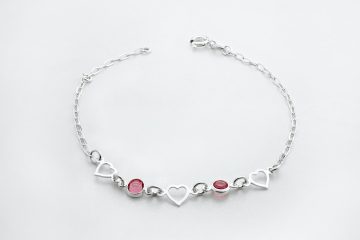Are you looking to unleash your creativity and add a personal touch to your jewelry collection? Bracelet braiding is a fantastic way to do just that. Whether you want to make unique gifts for your loved ones or simply enjoy the meditative process of creating something beautiful, bracelet braiding is a versatile craft that offers endless possibilities.
In this comprehensive guide, we will take you through the journey of mastering the art of bracelet braiding. From choosing the right materials to learning various braiding techniques, we will cover everything you need to know to get started. So, grab your favorite colors of thread or cord and let’s dive into the world of bracelet braiding!
1. Introduction to Bracelet Braiding
What is Bracelet Braiding?
Bracelet braiding is a technique that involves intertwining threads or cords to create intricate patterns and designs. It has been practiced for centuries in different cultures around the world and is known by various names, such as friendship bracelet making, macramé, or kumihimo. Bracelet braiding allows you to experiment with different colors, patterns, and textures, making it a highly customizable craft.
Benefits of Bracelet Braiding
Apart from the sheer joy of creating something with your own hands, bracelet braiding offers several benefits. It helps in improving focus and concentration, reduces stress, and promotes mindfulness. Engaging in this craft also allows you to express your individuality and creativity through unique designs. Additionally, bracelet braiding can be a great way to bond with friends and family, as you can exchange handmade bracelets as meaningful tokens of love and friendship.
2. Choosing the Right Materials
Thread or Cord Selection
The first step in bracelet braiding is selecting the right materials. When it comes to choosing the thread or cord for your bracelets, there are numerous options available. Cotton embroidery floss, nylon thread, hemp cord, and satin cord are commonly used materials. Consider factors such as durability, color options, and texture when making your selection.
Tools and Accessories
To get started with bracelet braiding, you’ll need a few essential tools and accessories. These include scissors, a ruler or measuring tape, a clipboard or safety pin to hold your work in place, and a closure mechanism such as a lobster clasp or a button. Be sure to have these items on hand before you begin your braiding journey.
3. Getting Started with Basic Techniques
The Forward Knot
The forward knot is a fundamental technique used in bracelet braiding. Begin by cutting three equal lengths of thread or cord, ensuring they are long enough to wrap around your wrist comfortably. Tie a knot at one end, leaving a small loop. Arrange the threads so that the outermost thread is in the middle and the other two are on the outside. Now, take the outermost thread on the right side and cross it over the middle thread, forming a loop. Pass the left outermost thread through the loop and pull it tight. This completes one forward knot. Repeat this process alternately with the left and right outermost threads until you achieve the desired length.
The Chevron Pattern
Once you have mastered the forward knot, you can move on to creating more intricate patterns, such as the chevron pattern. To create a chevron bracelet, begin with the forward knot technique. After a few knots, swap the outermost threads with the next ones in line. Continue this pattern until you achieve a chevron design. Experiment with different color combinations and thread arrangements to create unique variations.
4. Exploring Advanced Techniques
Adding Beads to Your Bracelets
To add an extra touch of elegance to your bracelets, consider incorporating beads into your designs. You can slide beads onto individual threads before tying the knots or thread them onto the middle cord as you braid. Beads come in various sizes, shapes, and colors, allowing you to create endless design possibilities.
Using Multiple Threads
If you want to create wider and more intricate bracelets, using multiple threads is a great technique. Start by doubling or tripling the number of threads used in the basic techniques. Follow the same knotting process, but keep in mind that you will have more threads to work with. Adjust the tension and spacing between the threads to achieve your desired pattern.
5. Adding Personal Touches
Embellishments and Charms
To make your bracelets truly unique, consider adding embellishments and charms. You can attach small pendants, gemstones, or personalized charms to your bracelets using jump rings or by incorporating them into the braiding process. These additions can reflect your personality or serve as reminders of special moments or people in your life.
Experimenting with Different Knots
While the forward knot is the most commonly used knot in bracelet braiding, don’t be afraid to experiment with other knotting techniques. The backward knot, the double knot, and the square knot are just a few examples of knots that can add variety and complexity to your designs. Explore tutorials and resources to learn different knotting methods and incorporate them into your bracelet braiding repertoire.
Conclusion
Bracelet braiding is a captivating craft that allows you to express your creativity while creating beautiful pieces of jewelry. From basic techniques to advanced patterns, this comprehensive guide has equipped you with the knowledge and skills needed to master the art of bracelet braiding. Remember to start with the basics, practice regularly, and let your imagination run wild. Whether you’re a beginner or an experienced braider, the journey of bracelet braiding is filled with endless possibilities and opportunities for self-expression.
FAQs
Q1: Can I use different materials for bracelet braiding?
Absolutely! Bracelet braiding can be done with various materials such as leather cords, silk threads, or even recycled materials like old t-shirts. The choice of material depends on your personal preference and the style you want to achieve.
Q2: How long does it take to make a bracelet?
The time taken to make a bracelet depends on various factors, including the complexity of the design, your braiding speed, and the materials used. Simple bracelets can be completed within an hour, while more intricate designs may take several hours or even days.
Q3: Can I wash my braided bracelets?
Most braided bracelets can be hand-washed using mild soap and water. However, it is essential to check the care instructions for the specific materials used, as some may require special care or be more delicate.
Q4: Can kids participate in bracelet braiding?
Bracelet braiding is a great activity for kids to develop their fine motor skills and creativity. However, adult supervision is recommended, especially when using scissors or working with small beads.
Q5: Where can I find inspiration for bracelet braiding patterns?
There are numerous resources available for bracelet braiding patterns, including books, online tutorials, and social media platforms such as Pinterest and Instagram. Explore different sources to find inspiration and develop your unique style.




